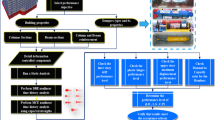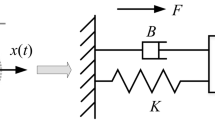Abstract
Objective
In this paper, vibration isolation and control for two types of representative engineering equipment are considered, i.e. sensitive equipment and machinery equipment.
Design
Isolation designs for the two equipments are carried out, respectively, for the purpose of chasing an optimal strategy and in which latest swarm intelligence—particle swarm optimization (PSO)—technique is adopted.
Methods
In the investigation of single-stage system for sensitive equipment, transmissibility of displacement of equipment and relative displacement between equipment and foundation show that this design cannot obtain a desired isolation effect, but an implementation using multi-objective PSO (MOPSO) technique can overcome this when both the objectives are balanced. Then a two-stage system is investigated, and the transmissibility indicates that the disadvantages can be effectively eliminated, and the obtained gbest solutions using MOPSO can prove this. Based on the two-stage passive isolation, active control is proposed for better vibration attenuation, which is focused on \(H_{\infty }\) criterion, and the control outputs are consisted of multi-objective fitness functions, and the latter strategy can seize the control effect of the two objectives well compared with the single-objective PSO-based \(H_{\infty }\) control. Following the strategies for the sensitive equipment, similar strategies for machinery equipment are performed promptly. In the single-stage system, transmissibility derivations of transmitted force to the foundation and inertial force of equipment are same with the ones of displacement and relative displacement of single-stage design of sensitive equipment; in addition, chunk foundation is often utilized for machinery equipment, and the vibration of which should be taken into consideration. In view of these, a two-stage system is proposed, and the transmissibility indicates a drift for entering into the desired isolation region is feasible and the MOPSO-based validation is presented. After this, active vibration control is also investigated, and a multi-objective control using \(H_{\infty }\) method is also performed using MOPSO, and the validations further confirm the importance and necessity of a multi-objective control.
Conclusion
Single-objective and multi-objective vibration controls should be taken into account for sensitive and machinery equipment, by which a balanced and optimized control can be performed.




























Similar content being viewed by others
References
Snowdon JC (1979) Vibration isolation: use and characterization [J]. J Acoust Soc Am 66(5):1245–1274
Shen Y, Yang S, Xing H et al (2015) Design of single degree-of-freedom optimally passive vibration isolation system[J]. J Vib Eng Technol 3(1):25–36
Hensley JM, Peters A, Chu S (1999) Active low frequency vertical vibration isolation [J]. Rev Sci Instrum 70(6):2735–2741
Winterflood J, Blair DG (1996) A long-period conical pendulum for vibration isolation [J]. Phys Lett A 222(3):141–147
Wei YD, Lai XB, Chen DZ, Shen GQ (2006) Optimal parameters design of two-stage vibration isolation system [J]. J Zhejiang Univ (Eng Sci) 40(5):893–896
Sommerfeldt SD, Tichy J (1990) Adaptive control of a two-stage vibration isolation mount [J]. J Acoust Soc Am 88(2):938–944
Sun T, Huang Z, Chen D (2005) Signal frequency-based semi-active fuzzy control for two-stage vibration isolation system[J]. J Sound Vib 280(3):965–981
Zhang CL, Mei DQ, Chen ZC (2002) Active vibration isolation of a micro-manufacturing platform based on a neural network [J]. J Mater Process Technol 129(1):634–639
Igusa T, Der Kiureghian A (1985) Dynamic characterization of two-degree-of-freedom equipment-structure systems [J]. J Eng Mech 111(1):1–19
Beard AM, Schubert DW, von Flotow AH (1994) Practical product implementation of an active, passive vibration isolation system[C]//SPIE’s 1994 international symposium on optics, imaging, and instrumentation. Int Soc Opt Photon 1994:38–49
Bronowicki AJ, MacDonald R, Gursel Y et al (2003) Dual stage passive vibration isolation for optical interferometer missions. In: Interferometry in space, vol 4852. International Society for Optics and Photonics, pp 753–764
Garoi F, Winterflood J, Ju L et al (2003) Passive vibration isolation using a Roberts linkage[J]. Rev Sci Instrum 74(7):3487–3491
Kamesh D, Pandiyan R, Ghosal A (2012) Passive vibration isolation of reaction wheel disturbances using a low frequency flexible space platform [J]. J Sound Vib 331(6):1310–1330
Jazar GN, Narimani A, Golnaraghi MF et al (2003) Practical frequency and time optimal design of passive linear vibration isolation mounts [J]. Veh Syst Dyn 39(6):437–466
Daley S, Hätönen J, Owens DH (2006) Active vibration isolation in a “smart spring” mount using a repetitive control approach [J]. Control Eng Pract 14(9):991–997
Du H, Sze KY, Lam J (2005) Semi-active H∞ control of vehicle suspension with magneto-rheological dampers [J]. J Sound Vib 283(3):981–996
Hrovat D (1993) Applications of optimal control to advanced automotive suspension design [J]. J Dyn Syst Meas Contr 115(2B):328–342
Kalaivani R, Lakshmi P, Rajeswari K (2015) An improved type-2 fuzzy logic approach based sliding mode controller for vehicle active suspension system [J]. J Vib Eng Technol 3(4):431–446
Shayeghi A, Shayeghi H, Kalasar HE (2009) Application of PSO technique for seismic control of tall building [J]. World Acad Sci Eng Technol 52:851–858
Holland JH (1975) Adaptation in natural and artificial systems: an introductory analysis with applications to biology, control, and artificial intelligence [M]. U Michigan Press
Eberhart R, Kennedy J (1995) A new optimizer using particle swarm theory. In: Proceedings of the sixth international symposium on micro machine and human science, 1995. MHS’95. IEEE, pp 39–43
Deepak B, Parhi DR, Raju B (2014) Advance particle swarm optimization-based navigational controller for mobile robot [J]. Arab J Sci Eng 39(8):6477–6487
Coello Coello CA, Lechuga MS (2002) MOPSO: a proposal for multiple objective particle swarm optimization[C]//Evolutionary Computation, 2002. CEC’02. In: Proceedings of the 2002 Congress on IEEE vol 2, pp 1051–1056
Fonseca CM, Fleming PJ (1995) An overview of evolutionary algorithms in multi-objective optimization[J]. Evol Comput 3(1):1–16
Marinaki M, Marinakis Y, Stavroulakis GE (2011) Fuzzy control optimized by a multi-objective particle swarm optimization algorithm for vibration suppression of smart structures [J]. Struct Multidiscip Optim 43(1):29–42
Sun K, Xu K, Zheng ZM et al (2014) Power transmission and transformation project establishing and decision-making based on ASU-MOPSO algorithm [J]. Appl Mech Mater 521:521–529
Rajagopal K, Ponnusamy L (2014) Multi objective optimization of vehicle active suspension system using debbo based pid controller. Int J Eng Technol 6(1):252–262
Parsopoulos KE, Vrahatis MN (2002) Particle swarm optimization method in multiobjective problems[C]//Proceedings of the 2002 ACM symposium on applied computing. ACM, pp 603–607
Fieldsend JE (2002) A multi-objective algorithm based upon particle swarm optimisation, an efficient data structure and turbulence. In: Proceedings of 2002 UK workshop on computational intelligence, pp 37–44
Li X (2003) A non-dominated sorting particle swarm optimizer for multiobjective optimization[C]//genetic and evolutionary computation—GECCO 2003. Springer, Berlin, pp 37–48
Deb K, Pratap A, Agarwal S et al (2002) A fast and elitist multiobjective genetic algorithm: NSGA-II [J]. Evol Comput IEEE Trans 6(2):182–197
Goldberg DE, Richardson J (1987) Genetic algorithms with sharing for multimodal function optimization[C]//Genetic algorithms and their applications. In: Proceedings of the second international conference on genetic algorithms. Lawrence Erlbaum, Hillsdale, pp 41–49
Farshidianfar A, Saghafi A, Kalami SM et al (2012) Active vibration isolation of machinery and sensitive equipment using H∞ control criterion and particle swarm optimization method[J]. Meccanica 47(2):437–453
Acknowledgements
This research is completely supported by National Natural Science Foundation of China, and the Grant nos. are 51078123, 51179043; and it is also launched as preparation for the revising work of ‘Code for design of vibration isolation’ (national code of China). Valuable comments and suggestions by preparation experts of the national code—‘Code for vibration load design of industrial building’ (national code of China) on the ideas carried out are gratefully acknowledged.
Author information
Authors and Affiliations
Corresponding author
Rights and permissions
About this article
Cite this article
Huang, W., Xu, J., Lu, Xz. et al. Research on Representative Engineering Vibration Isolation and Control Using Particle Swarm Optimization Technique. J. Vib. Eng. Technol. 6, 179–195 (2018). https://doi.org/10.1007/s42417-018-0030-7
Received:
Revised:
Accepted:
Published:
Issue Date:
DOI: https://doi.org/10.1007/s42417-018-0030-7




